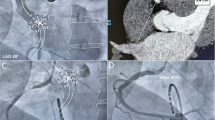Abstract
Purpose
The purpose of this study was to assess the differences in cooling behavior between the first-generation cryoballoon (CB-1G) and the second-generation cryoballoon (CB-2G) quantitatively to understand the freezing capabilities and to benefit from the improved efficacy of the CB-2G in patients with atrial fibrillation.
Methods
We analyzed quantitatively the ice formation of the CB-1G and CB-2G catheters in vitro in a 37 °C warm water bath during freezing for 60, 120, 180, 240, and 300 s, respectively.
Results
The mean-covered surface area and the relative coverage of the ice spots on the CB-2G were significantly different from the spots on the CB-1G for the 28-mm CBs but not for the 23-mm CBs. Whereas for the CB-1G, the ice formation was discontiguous with four isolated ice spots; the CB-2G showed a contiguous ice cap covering the entire distal part including the pole of the balloon. No homogeneous cooling behavior could be observed at the equatorial level with both catheters. Temporal differences on the ice formation could be observed for the 28-mm CB-2G but not for the 23-mm CB-2G.
Conclusion
The new-generation CB-2G showed more powerful and homogeneous cooling behavior, especially for the 28-mm CB. Whether this translates into higher long-term success rates is currently unknown. The impact of the more effective cooling and the longer dissolving duration of the ice cap of the new-generation CB-2G on procedural safety needs to be investigated.



Similar content being viewed by others
References
Knecht, S., Kühne, M., Altmann, D., Ammann, P., Schaer, B., Osswald, S., & Sticherling, C. (2013). Anatomical predictors for acute and mid-term success of cryoballoon ablation of atrial fibrillation using the 28mm balloon. Journal of Cardiovascular Electrophysiology, 24, 132–138.
URL [Internet]. Available from: http://www.medtronic.com/for-healthcare-professionals/products-therapies/cardiac-rhythm/ablation-products-for-atrial-fibrillation/arctic-front/index.htm#tab1, Accessed 24th of July 2013.
Andrade, J. G., Dubuc, M., Guerra, P. G., Landry, E., Coulombe, N., Leduc, H., Rivard, L., Macle, L., Thibault, B., Talajic, M., Roy, D., & Khairy, P. (2013). Pulmonary vein isolation using a second-generation cryoballoon catheter: a randomized comparison of ablation duration and method of deflation. Journal of Cardiovascular Electrophysiology, 24, 692–698.
Coulombe, N., Paulin, J., & Su, W. (2013). Improved in vivo performance of second-generation cryoballoon for pulmonary vein isolation. Journal of Cardiovascular Electrophysiology, 24, 919–925.
Fürnkranz, A., Bordignon, S., Schmidt, B., Gunawardene, M., Schulte-Hahn, B., Urban, V., Bode, F., Nowak, B., & Chun, J. K. R. (2013). Improved procedural efficacy of pulmonary vein isolation using the novel second-generation cryoballoon. Journal of Cardiovascular Electrophysiology, 24, 492–497.
Hussain, S. K., & Ferguson, J. D. (2013). Cool enough-halving pulmonary vein isolation time with the cryoballoon catheter. Journal of Cardiovascular Electrophysiology, 24, 699–700.
Andrade, J. G., Dubuc, M., Guerra, P. G., Macle, L., Mondésert, B., Rivard, L., Roy, D., Talajic, M., Thibault, B., & Khairy, P. (2012). The biophysics and biomechanics of cryoballoon ablation. Pacing and Clinical Electrophysiology, 35, 1162–1168.
Available from: http://www.accessdata.fda.gov/scripts/cdrh/cfdocs/cfpma/pma.cfm?id=19003, Accessed 17th of September 2013.
Kühne, M., Knecht, S., Altmann, D., Kawel, N., Ammann, P., Schaer, B., Osswald, S., & Sticherling, C. (2013). Phrenic nerve palsy during ablation of atrial fibrillation using a 28-mm cryoballoon catheter: predictors and prevention. Journal of Interventional Cardiac Electrophysiology, 36, 47–54.
Author information
Authors and Affiliations
Corresponding author
Additional information
Sven Knecht and Michael Kühne contributed equally to this manuscript
Rights and permissions
About this article
Cite this article
Knecht, S., Kühne, M., Osswald, S. et al. Quantitative assessment of a second-generation cryoballoon ablation catheter with new cooling technology—a perspective on potential implications on outcome. J Interv Card Electrophysiol 40, 17–21 (2014). https://doi.org/10.1007/s10840-014-9883-1
Received:
Accepted:
Published:
Issue Date:
DOI: https://doi.org/10.1007/s10840-014-9883-1




